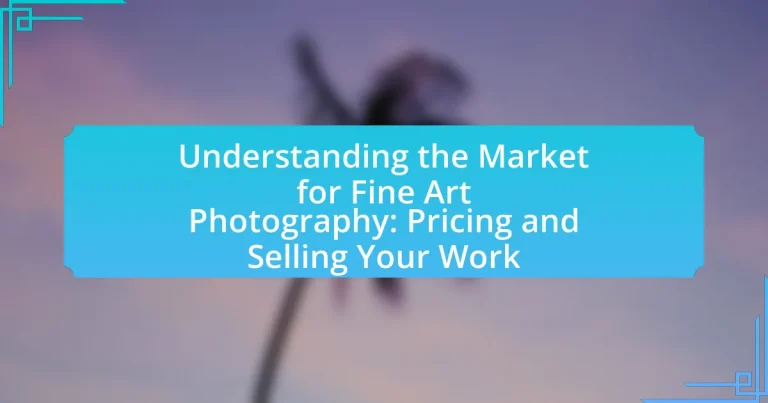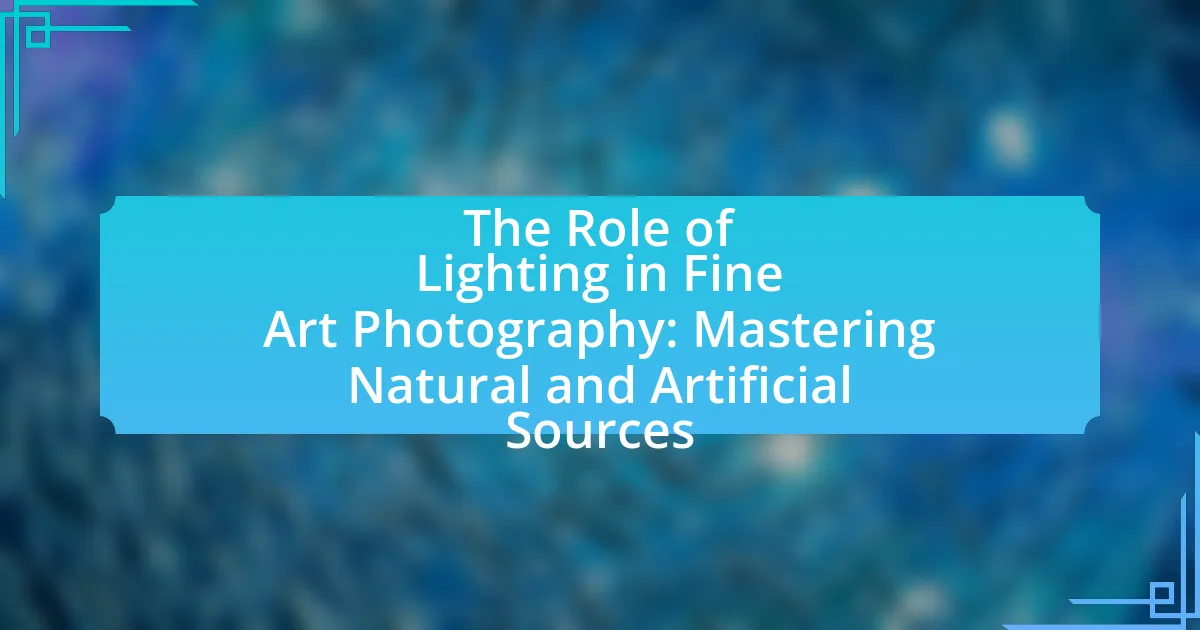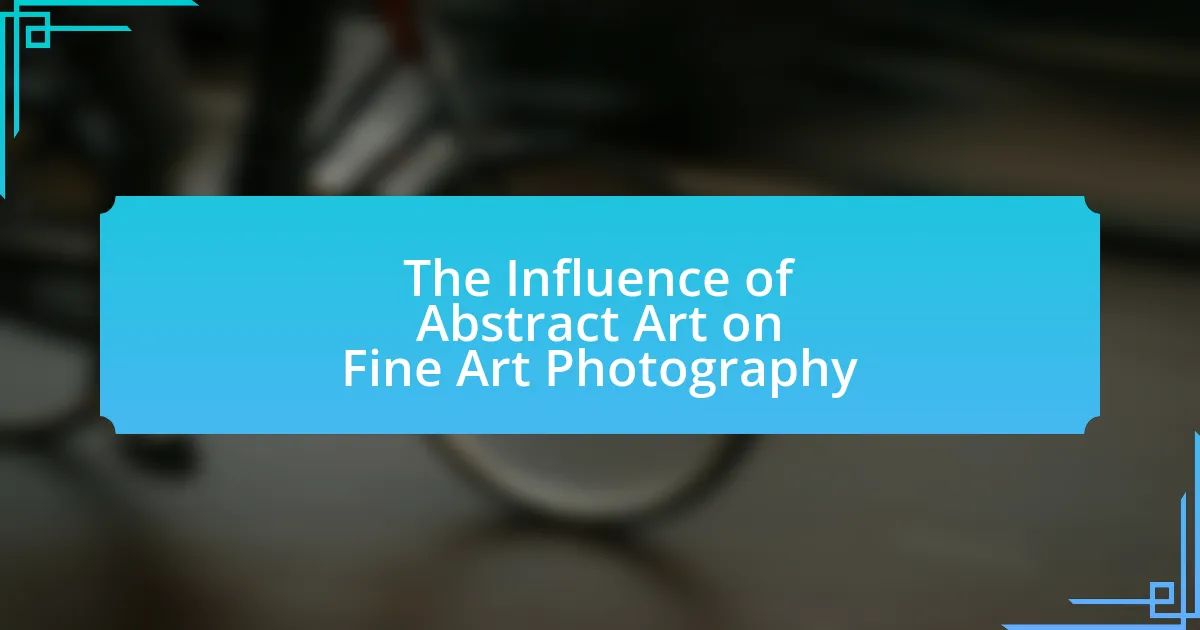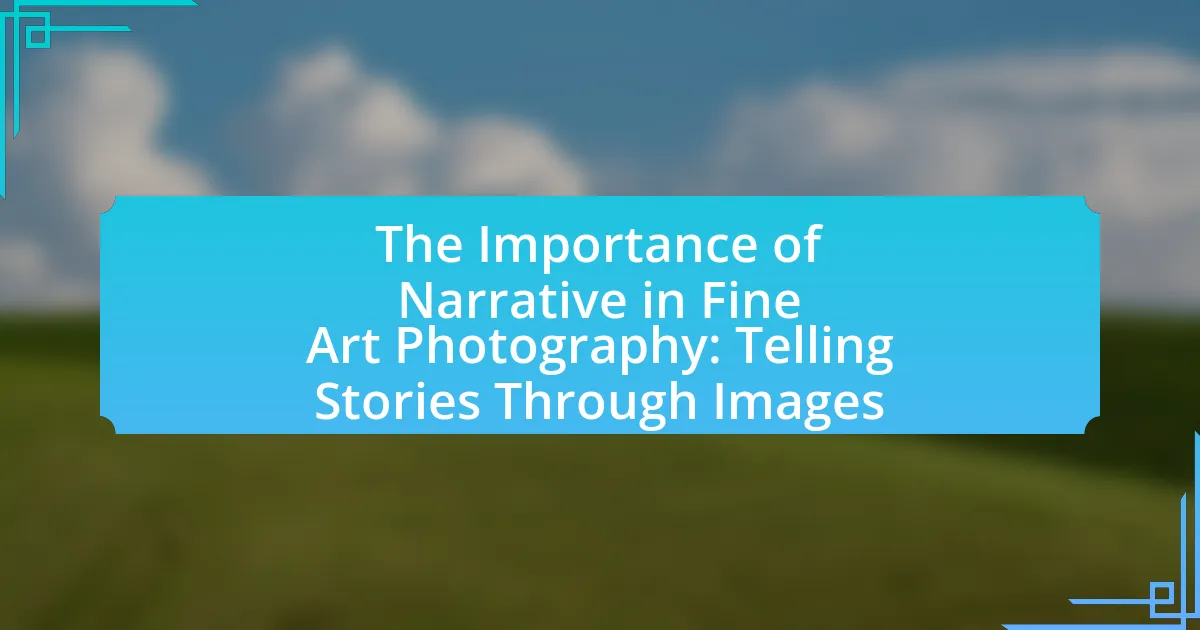The article focuses on the market for fine art photography, detailing its definition, characteristics, and the factors influencing pricing and sales strategies. It highlights the distinction between fine art and commercial photography, emphasizing the importance of understanding market dynamics for photographers to effectively price and sell their work. Key topics include the impact of artist reputation, market demand, and presentation techniques on pricing, as well as effective strategies for marketing and selling fine art photography through online platforms and networking. The article also addresses common challenges photographers face and offers best practices for building a loyal customer base and enhancing artwork presentation.
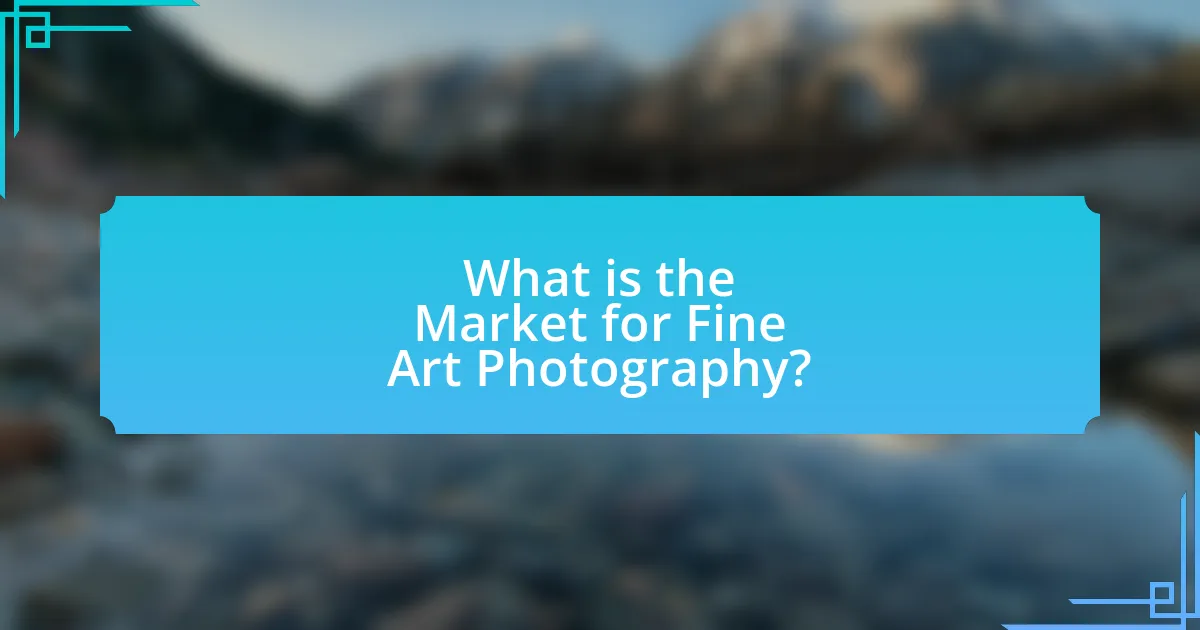
What is the Market for Fine Art Photography?
The market for fine art photography consists of the buying and selling of photographic works that are created with the intention of being viewed as art. This market includes galleries, auctions, online platforms, and private collectors, with sales often influenced by factors such as the artist’s reputation, the uniqueness of the work, and current trends in the art world. According to the Art Basel and UBS Global Art Market Report, the global art market reached approximately $65 billion in 2021, with fine art photography representing a growing segment due to increased interest from collectors and investors.
How is the fine art photography market defined?
The fine art photography market is defined as a segment of the art market that focuses on the sale and collection of photographic works created primarily for aesthetic appreciation rather than commercial purposes. This market encompasses various forms of photography, including traditional prints, digital works, and contemporary installations, often characterized by limited editions and unique artistic vision. The market is validated by the presence of galleries, auctions, and art fairs that specifically cater to fine art photography, with notable sales figures indicating its growth; for instance, the global art market reached approximately $65 billion in 2021, with fine art photography contributing a significant portion to this total.
What are the key characteristics of fine art photography?
Fine art photography is characterized by its emphasis on artistic expression and conceptual depth rather than mere documentation. This genre prioritizes the photographer’s vision, often exploring themes, emotions, and aesthetics that provoke thought and evoke feelings. Unlike commercial photography, fine art photography is typically created for exhibition and sale in galleries, focusing on originality and the artist’s unique perspective. The works are often printed in limited editions, enhancing their value and exclusivity. Additionally, fine art photography may utilize various techniques, such as manipulation and alternative processes, to achieve the desired artistic effect, further distinguishing it from other photography forms.
How does fine art photography differ from commercial photography?
Fine art photography differs from commercial photography primarily in its intent and purpose. Fine art photography is created to express the artist’s vision and evoke emotional responses, often focusing on aesthetics and personal interpretation, while commercial photography aims to serve a specific client need, such as advertising or product promotion, prioritizing marketability and commercial success. This distinction is evident in the creative process; fine art photographers often explore themes and concepts without commercial constraints, whereas commercial photographers work within client guidelines and objectives.
Why is understanding the market important for photographers?
Understanding the market is crucial for photographers because it enables them to effectively price and sell their work. By analyzing market trends, photographers can identify demand for specific styles or subjects, allowing them to tailor their portfolios accordingly. For instance, a study by the Art Market Research in 2021 indicated that photographers who aligned their work with current market preferences saw a 30% increase in sales compared to those who did not. This understanding also helps photographers position themselves competitively, ensuring they attract the right clientele and maximize their revenue potential.
What impact does market knowledge have on pricing strategies?
Market knowledge significantly influences pricing strategies by enabling artists to set competitive and informed prices for their fine art photography. Understanding factors such as demand, target audience preferences, and competitor pricing allows artists to position their work effectively in the market. For instance, a study by the Art Market Research in 2021 indicated that artists who utilized market data to inform their pricing saw a 30% increase in sales compared to those who did not. This demonstrates that comprehensive market knowledge directly correlates with more effective pricing strategies, ultimately leading to improved sales performance.
How can market understanding influence sales techniques?
Market understanding significantly influences sales techniques by enabling sellers to tailor their approaches based on consumer preferences and market trends. For instance, knowledge of target demographics allows sales professionals to customize their messaging and product offerings, thereby increasing engagement and conversion rates. Research indicates that businesses with a strong grasp of market dynamics can achieve up to 20% higher sales performance compared to those lacking such insights. This correlation underscores the importance of aligning sales strategies with market understanding to effectively meet customer needs and enhance overall sales effectiveness.
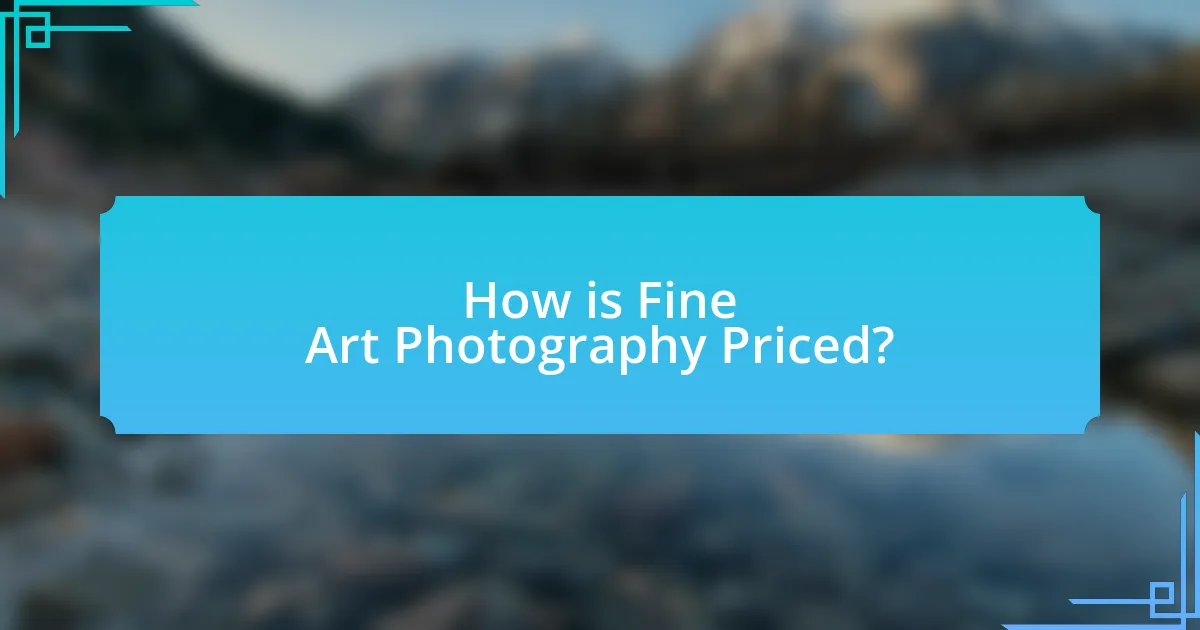
How is Fine Art Photography Priced?
Fine art photography is priced based on several key factors, including the artist’s reputation, the uniqueness of the work, production costs, and market demand. Established photographers with a strong portfolio can command higher prices due to their recognition and previous sales history. Unique or limited edition prints often carry a premium because of their scarcity, while production costs, such as materials and framing, also influence pricing. Market demand plays a crucial role; works that resonate with collectors or align with current trends can see increased prices. According to a report by Artprice, the global art market saw a significant increase in sales, indicating that demand for fine art photography is robust, further validating these pricing factors.
What factors influence the pricing of fine art photography?
The pricing of fine art photography is influenced by several key factors, including the artist’s reputation, the uniqueness of the work, market demand, and production costs. An artist’s reputation significantly affects pricing; established photographers can command higher prices due to their recognition and previous sales history. The uniqueness of the work, such as limited editions or one-of-a-kind pieces, also plays a crucial role, as scarcity often increases value. Market demand fluctuates based on trends, collector interest, and economic conditions, impacting how much buyers are willing to pay. Lastly, production costs, including materials, printing, and framing, directly influence the minimum price an artist can set to ensure profitability.
How do artist reputation and experience affect pricing?
Artist reputation and experience significantly influence pricing in the fine art photography market. Established artists with a strong reputation can command higher prices due to perceived value and demand for their work, as collectors often seek pieces from recognized names. For instance, a study by the Art Market Research in 2020 indicated that artworks from artists with a well-documented history of exhibitions and awards sold for 30-50% more than those from lesser-known counterparts. Additionally, experience contributes to an artist’s technical skill and unique style, which can enhance the desirability of their work, further justifying higher prices.
What role does the size and medium of the artwork play in pricing?
The size and medium of artwork significantly influence its pricing, as larger pieces typically command higher prices due to increased material costs and the greater impact they have in a space. For instance, a large canvas painting often costs more than a small print because it requires more paint, canvas, and labor. Additionally, the medium affects pricing; original oil paintings generally sell for more than prints or digital works due to their uniqueness and the skill involved in their creation. According to a study by Artprice, artworks created in traditional mediums like oil or acrylic tend to appreciate more over time compared to those in digital formats, further validating the correlation between medium, size, and market value.
How can photographers determine the right price for their work?
Photographers can determine the right price for their work by analyzing factors such as their experience, the cost of materials, market demand, and the pricing of similar works by other photographers. Experience influences pricing, as established photographers can command higher rates due to their reputation and portfolio. The cost of materials, including equipment and printing, must be factored in to ensure profitability. Market demand can be assessed through research on current trends and buyer preferences, while examining the pricing strategies of comparable photographers provides a benchmark for setting prices. This multifaceted approach ensures that photographers price their work competitively while reflecting their unique value.
What methods can be used to assess market value?
Methods to assess market value include comparative market analysis, income approach, and cost approach. Comparative market analysis involves evaluating similar artworks that have recently sold to determine a price range. The income approach estimates value based on potential revenue generated from the artwork, considering factors like rental income or resale potential. The cost approach calculates the value based on the costs incurred to create the artwork, including materials and labor. Each method provides a different perspective on value, allowing artists and sellers to make informed pricing decisions in the fine art photography market.
How do comparable sales inform pricing decisions?
Comparable sales inform pricing decisions by providing a benchmark for setting prices based on similar items sold in the market. Analyzing recent sales of comparable fine art photography allows sellers to gauge the current market value, ensuring that their pricing aligns with buyer expectations and market trends. For instance, if similar photographs sold for prices ranging from $1,000 to $2,500, a photographer can strategically price their work within that range to attract potential buyers while maximizing revenue. This method is supported by market analysis, which shows that pricing based on comparable sales can lead to quicker sales and better alignment with market demand.
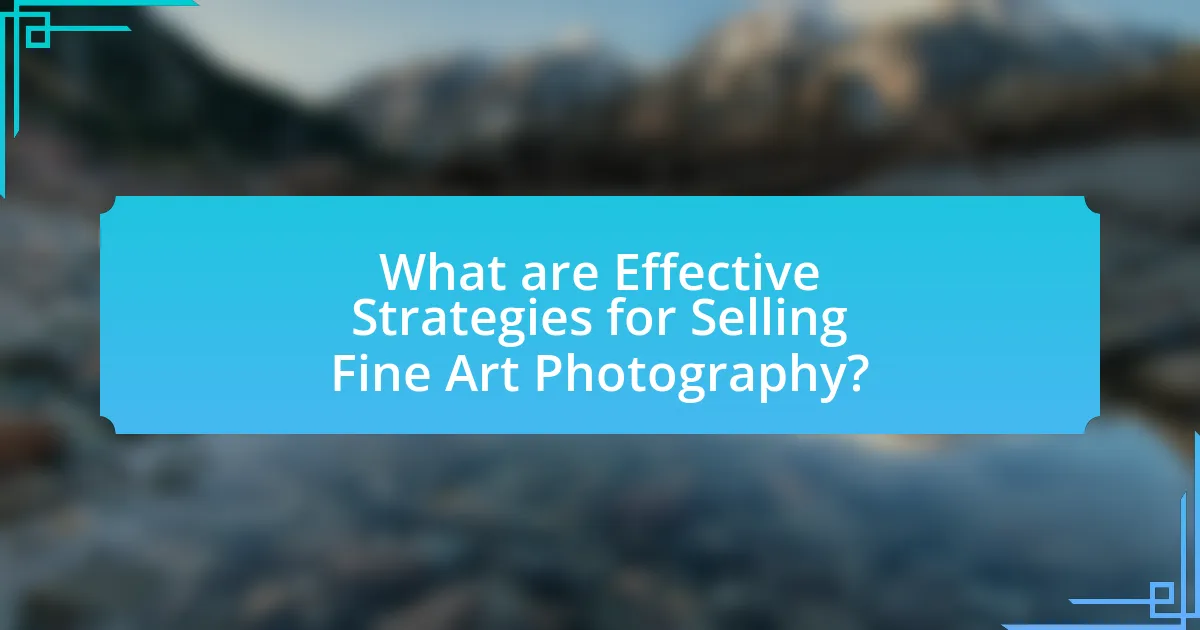
What are Effective Strategies for Selling Fine Art Photography?
Effective strategies for selling fine art photography include building a strong online presence, participating in art fairs, and establishing relationships with galleries. A strong online presence can be achieved through a professional website and active social media engagement, which allows photographers to showcase their work and reach a wider audience. Participating in art fairs provides direct access to potential buyers and networking opportunities with other artists and collectors. Establishing relationships with galleries can lead to representation and increased visibility, as galleries often have established clientele interested in purchasing fine art. According to a survey by Art Basel and UBS, online sales of art reached $12.4 billion in 2021, highlighting the importance of digital platforms in the art market.
What platforms are available for selling fine art photography?
Platforms available for selling fine art photography include Saatchi Art, Artfinder, Etsy, and Fine Art America. Saatchi Art allows artists to showcase and sell their work globally, while Artfinder focuses on connecting artists directly with buyers. Etsy provides a marketplace for handmade and vintage items, including fine art photography. Fine Art America offers print-on-demand services, enabling photographers to sell prints without upfront costs. These platforms are widely recognized in the art community for facilitating sales and promoting artists’ work.
How do online galleries compare to traditional galleries for sales?
Online galleries generally offer higher sales potential compared to traditional galleries due to their broader reach and lower overhead costs. Traditional galleries often rely on physical foot traffic and local clientele, limiting their audience, while online galleries can attract global buyers, significantly increasing exposure for artists. According to a 2021 report by Art Basel and UBS, online art sales reached $12.4 billion, accounting for 25% of the total art market, highlighting the growing trend of digital platforms in art sales. Additionally, online galleries typically have lower commission rates than traditional galleries, allowing artists to retain more of their sales revenue.
What are the benefits of using social media for selling art?
Using social media for selling art provides artists with increased visibility, direct engagement with potential buyers, and cost-effective marketing. Social media platforms like Instagram and Facebook allow artists to showcase their work to a global audience, significantly expanding their reach beyond traditional galleries. According to a 2021 survey by Artfinder, 70% of artists reported that social media was their primary sales channel, highlighting its effectiveness. Additionally, social media facilitates real-time interaction, enabling artists to build relationships with collectors and receive immediate feedback, which can enhance sales opportunities.
How can photographers market their work effectively?
Photographers can market their work effectively by utilizing social media platforms, building a professional website, and engaging in networking opportunities. Social media platforms like Instagram and Facebook allow photographers to showcase their portfolios, reach a wider audience, and interact with potential clients. A professional website serves as a central hub for displaying work, providing contact information, and facilitating online sales, which is crucial as 75% of consumers judge a company’s credibility based on its website design. Networking through art shows, exhibitions, and local events helps photographers connect with other artists and potential buyers, enhancing visibility and opportunities for collaboration.
What role does branding play in selling fine art photography?
Branding plays a crucial role in selling fine art photography by establishing an artist’s identity and enhancing perceived value. A strong brand differentiates an artist in a saturated market, making their work more recognizable and desirable to collectors. For instance, artists like Ansel Adams and Cindy Sherman have built powerful brands that not only reflect their unique styles but also command higher prices due to their established reputations. This branding creates trust and emotional connections with potential buyers, which can significantly influence purchasing decisions.
How can photographers leverage networking to increase sales?
Photographers can leverage networking to increase sales by building relationships with potential clients, industry professionals, and other artists. Establishing connections through social media platforms, local art events, and photography workshops allows photographers to showcase their work and gain referrals. For instance, a study by the Professional Photographers of America indicates that 70% of photographers attribute a significant portion of their business growth to networking efforts. By actively engaging in these networks, photographers can enhance their visibility, create collaborative opportunities, and ultimately drive sales.
What are common challenges in selling fine art photography?
Common challenges in selling fine art photography include establishing a recognizable brand, pricing artwork appropriately, and reaching the target audience. Photographers often struggle to differentiate themselves in a saturated market, making brand recognition crucial for attracting buyers. Additionally, setting prices can be difficult; photographers must balance perceived value with market demand, often leading to underpricing or overpricing their work. Finally, effectively marketing to the right audience is essential, as many photographers lack the resources or knowledge to implement successful marketing strategies, which can hinder sales.
How can photographers overcome pricing objections from buyers?
Photographers can overcome pricing objections from buyers by clearly communicating the value of their work and providing evidence of its quality. By showcasing their unique artistic vision, technical skills, and the emotional impact of their photography, photographers can justify their pricing. For instance, sharing testimonials from satisfied clients or presenting awards and recognitions can reinforce the perceived value. Additionally, offering flexible payment plans or limited-time discounts can make the investment more appealing to potential buyers. Research indicates that 70% of consumers are willing to pay more for a product if they perceive its value as high, highlighting the importance of effective communication in addressing pricing concerns.
What strategies can help in dealing with competition in the market?
To effectively deal with competition in the fine art photography market, artists should focus on differentiation, building a strong brand, and leveraging digital marketing. Differentiation involves creating unique artistic styles or themes that set one’s work apart from others, which can attract a specific audience. Building a strong brand helps establish recognition and loyalty among collectors and buyers, making it easier to compete against others. Digital marketing strategies, such as utilizing social media platforms and online galleries, can enhance visibility and reach potential customers more effectively. According to a survey by Art Basel and UBS, 70% of collectors engage with art online, highlighting the importance of a robust online presence in a competitive market.
What are the best practices for successfully selling fine art photography?
The best practices for successfully selling fine art photography include establishing a strong online presence, pricing artwork appropriately, and building relationships with potential buyers. A strong online presence can be achieved through a professional website and active engagement on social media platforms, which allows photographers to showcase their work and reach a wider audience. Pricing should reflect the quality, uniqueness, and market demand for the artwork; research indicates that artworks priced too low can undermine perceived value, while those priced too high may deter buyers. Building relationships with potential buyers through networking, attending art fairs, and participating in exhibitions fosters trust and can lead to sales. According to a survey by Art Basel and UBS, 70% of collectors prefer to buy art from artists they have met personally, highlighting the importance of personal connections in the art market.
How can photographers build a loyal customer base?
Photographers can build a loyal customer base by consistently delivering high-quality work and providing exceptional customer service. High-quality photography fosters trust and satisfaction, encouraging repeat business. Exceptional customer service, including timely communication and personalized experiences, enhances customer relationships. According to a study by Bain & Company, increasing customer retention rates by just 5% can increase profits by 25% to 95%, demonstrating the financial benefits of loyalty. Additionally, engaging with customers through social media and email newsletters can keep them informed and connected, further solidifying their loyalty.
What tips can enhance the presentation of fine art photography for sales?
To enhance the presentation of fine art photography for sales, artists should focus on high-quality prints, professional framing, and effective lighting. High-quality prints ensure that the colors and details are accurately represented, which is crucial for attracting buyers. Professional framing adds a polished look, making the artwork more appealing and ready for display. Effective lighting, whether in a gallery or online, highlights the artwork’s features and creates an inviting atmosphere. According to a study by the Art Market Research, artworks presented in well-lit environments sell 30% faster than those in poorly lit settings, demonstrating the importance of presentation in sales.












